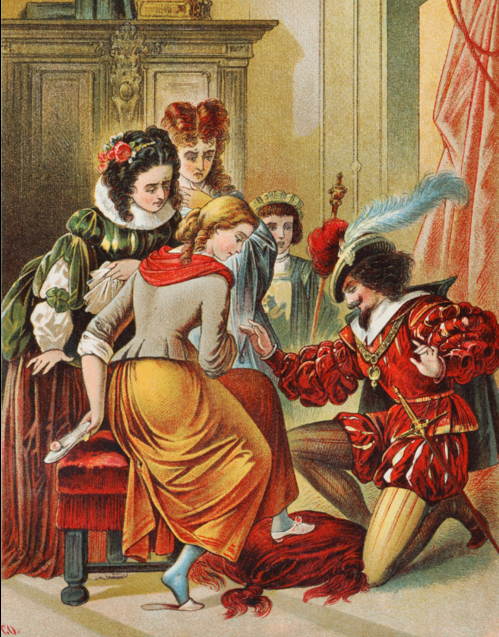Tips for Pronouncing the “thdh” Combination in Some Irish Words from the List of ‘Gaolta Teaghlaigh’ (Family Relationships) Posted by róislín on Nov 19, 2016 in Irish Language
(le Róislín)

An leathdheirfiúracha nó leasdeirfiúracha atá ag Luaithríona sa scéal seo? Freagra thíos (faoin nóta). “Cinderella” by Carl Offterdinger, c. late 19th C. Public Domain image. – See more at: http://www.revivingherstory.com/rhblog/2015/6/3/from-prostitute-to-princess-cinderellas-dark-history#sthash.rNfmW3rC.dpuf
There are a few pairs of words in our most recent blog about gaolta teaghlaigh (family relationships) that might be a little puzzling to pronounce, for newcomers to the language. This blogpost will deal with the following pairs; if you have questions about others, please feel free to write in and ask.
leasdeirfiúr, leathdheirfiúr
leasdeartháir, leathdheartháir
For a review of the translations, please see the note at the end of the article.
With the first pair, we see an “s/d” combination and with the second a “th/dh” combination. They’re not actually difficult to pronounce — it’s just a matter of interpreting the spelling.
For “leasdeirfiúr,” we have the “leas-” [lyass-] prefix and then “deirfiúr” [DJERzh-uh-fyoor]. And the good news is we simply have a slight break between the “s-” and the “-d” sounds. The “deirfiúr” part retains its initial stress, so in the end, we have [LyASS-DJERzh-uh-fyoor]. There is a slight vowel sound between the “r” and “f” of “deirfiúr” that is not indicated in the spelling.
“Leasdeartháir” works the same way: the “leas-” [lyass-] prefix and then “deartháir” [DJAR-haw-ir zh], so the full word is [LyASS-DJAR-haw-irzh].
“Leathdheirfiúr” and “leathdheartháir” may seem a little trickier but the sound isn’t really difficult, it’s just the correlation to the spelling (an endless issue in learning Irish, it seems). The key is that the “-th” of “leath-” is basically silent, at most a slight puff of breath and the “dh” is basically a “y” sound. That may seem like a strange way to spell a “y” sound but so be it. You’ve probably already used that sound many times, in phrases like “a Dhiarmaid,” “mo dheirfiúr,” “mo dheartháir,” or “a Dhia,” or as the latest buzzword has us saying, for OMD (which the popular, though not “caighdeánach,” translation of the English phrase “OMG”), “Ó mo Dhia.” I know, I know, people object to the use of “mo” here as non-traditional, since the trad way would be “Ó, a Dhia,” but I’m not trying to prescribe usage for anyone, just indicate what it sounds like if you’re going to say it. So the “dh-” at the beginning of “dheirfiúr” and “dheartháir” is basically a “y” sound, giving us: .
leathdheirfiúr: LyA-YERzh-uh-fyoor]. The “a” of the “LyA-” part is like the “-ea-” in Irish “deas” or “geal,” or American English “bat” or “cat,” not like the “la” in “do-re-mi-fa-so-la-ti-do.”
leathdheartháir: LyA-YAR-haw-irzh], with the “leath– ” as noted above.
To sum it up, we could simply say that the “dh” in “-dheirfiúr” and “-dheartháir” is silent, but that wouldn’t lead us to include the “y” sound.
So, while on the surface, the prefixes “leas-” and “leath-” may seem to work very similarly, in reality, they don’t, at least as far as pronunciation goes. “Leath-,” with its “-th” ending, causes lenition (séimhiú or “softening”) of the “d” of “deirfiúr” and “deartháir.” The “d” changes to “dh” and is no longer pronounced. But a final “s,” as in “leas-,” doesn’t. Why? The so-called DNTLS rule, which reminds us that “d” resists lenition after a preceding “s.” And, for that matter, it also resists lenition after “n,” which is why Irish has words like “an-dona” (no change from basic “dona“) but “an-mhaith” (with “maith” getting lenited, i.e. changing to “mh” and changing in pronunciation). But all the aspects of the DNTLS rule, including the “ana-dhona” variation, will have to wait for blagmhír éigin eile.
If anyone wants, I can rewrite these pointers for the “driofúr” and “driotháir” versions of the words, but since those are considered dialect to begin with, there’s probably less need for pronunciation guidelines. Hope this helped clarify any pronunciation questions you might have. SGF — Róislín
Nóta (na haistriúcháin)
leasdeirfiúr (stepsister), leathdheirfiúr (half-sister)
leasdeartháir (stepbrother), leathdheartháir (half-brother)
Freagra don cheist faoin bpictiúr:
leasdeirfiúracha, ar ndóigh — fad ár n-eolais ; )

Build vocabulary, practice pronunciation, and more with Transparent Language Online. Available anytime, anywhere, on any device.




Comments:
Ross:
Ar mhiste leat na téarmaí “leath-dHriofúr” agus “leath-dHriotháir” a fhuaimniú, le do thoil, a Róislín? Rinne mé cuardach ar an bhfuaim “dhri”, ach níor aimsigh mé aon rud.
Agus ar miste leat, dá gcuirfinn ceist ort faoi cén chanúint a labhraíonn tú? Bím ag éisteacht leis an fhoghráiocht ar Teanglann.ie/Foclóir.ie/Forvo.com go minic agus uaireanta bíonn na fuaimeanna go léir an-difriúil, mar shampla “deartháir”
Maith dom mo chuid Gaeilge. Go raibh míle maith agat as do bhlag iontach.
Ross
Ross:
Cuireann an focal “roinnt” mearbhall orm freisin. Úsáideann tú [rinch]=winch sa bhlag seo ach cheapaim go bhfuil trí fhuaimniú eile i Foclóir.ie. Is crá croí ceart é 🙂
[reent]=Ree-nt
[rhint]=Rhine-t
[wrench]=wrench
róislín:
@Ross Mholfainn canúint amháin a roghnú agus a úsáid, canúint do mhuintire, más féidir (is más mian leat í). Go minic bíonn a lán foghraíochtaí difriúla ag focal amháin i nGaeilge. Tarlaíonn sin i mBéarla amanna freisin (route/route le guta mar “root is mar “rout”; roof/roof (guta mar “goof” is mar “hoof”). Ach déarfainn go dtarlaíonn sé níos minice i nGaeilge. Cuirim féin an fhuaim “i” (IPA /I/ ach “Irish-modified IPA /i/) leis san fhocal “roinnt.” Chuala mé na fuaimeanna eile go minic go leor.